MARIANI’S
August
26, 2007
NEWSLETTER
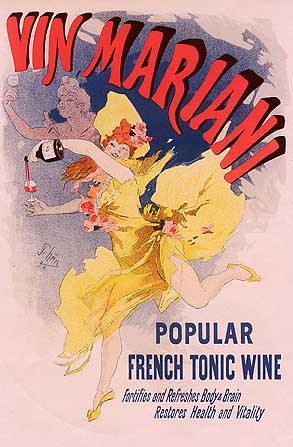
Vin Mariani Poster by Jules Cheret (1894)
WEBSITE: To
go to my web site, in which I will update food
&
travel information and help link readers to other first-rate travel
& food sites, click on: home page
ARCHIVE: Readers may now access
an
Archive of all past newsletters--each annotated--dating back to July,
2003, by simply clicking on www.johnmariani.com/archive
SUBSCRIBE AND
UN-SUBSCRIBE: You may subscribe anyone you wish
to this newsletter--free of charge--by
clicking here.
In
This Issue
NEW YORK CORNER: The E.U. by John Mariani
NOTES FROM THE WINE CELLAR:
QUICK BYTES
~~~~~~~~~~~~~~~~~~~~~~~~~~~~~~~~~~~~
MY FAVORITE MANSIONS
by John Mariani
Villa Cipriani

Via Canova, 298, Asolo
011-(39-0423-523411
website
It's hard to imagine that there are any pockets of Italy that have not been discovered and swamped by the global tourist crowd, and cities like Rome, Florence, and Venice are now completely overwhelmed from April through October by such throngs of visitors that they have become an endurance test of one's will to wait on line for hours to get into the Uffizi, the Sistine Chapel, or the Doges Palace. To have any sense of respite one must leave those cities and head out of town, and Asolo, an hour's drive from Venice, is exactly that.
Asolo is an old Roman town whose development was spurred by the arrival in 1489 of Caterina Cornaro, a Venetian who became the Queen of Cyprus but due to the usual intrigues was banished back to Italy and given Asolo as a way to keep her from returning. Once she saw Asolo, she never did, and she proceeded to bring the hilltop town an esthetic reputation it continued to enjoy even after she was recalled to Venice during a threat of war.
Here you have repose, here you may relax in the garden, here you may dine whenever you like. No one knows who the original architect of this Palladian era villa was, but by 1889 it was known as a beautiful spot for Europeans to stop and stay. No less than Robert Browning visited that year and bought the place outright, and his last volume of verses, written that same year, was entitled Asolando. His son, Robert Wiedemann Barrett Browning, inherited the Villa then sold it in 1902 to a Trevisan engineer, who gave it to his daughter as a wedding gift on her marriage to Sebastiano Galanti; he later ceded it to the manager of the Rifugio del Grappa, who transformed the property into a country hotel named “Belvedere.”
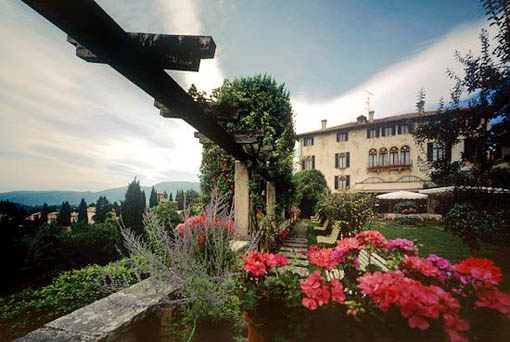 It remained that until the
1950s when the Guinness
bought the villa and made it into an elegant boutique hotel as Hotel
Villa Cipriani, which once but no longer had a connection with
the
Ciprianis
of Harry's Bar fame in Venice. In 1998 Starwood Hotels & Resorts Worldwide took it over and further made it into a
marvelous hotel on the flowered hills of the small walled town of
Asolo.
It remained that until the
1950s when the Guinness
bought the villa and made it into an elegant boutique hotel as Hotel
Villa Cipriani, which once but no longer had a connection with
the
Ciprianis
of Harry's Bar fame in Venice. In 1998 Starwood Hotels & Resorts Worldwide took it over and further made it into a
marvelous hotel on the flowered hills of the small walled town of
Asolo.The dominant features of the Villa are two: one, the view from just about any of the 31 rooms is inspiring for its breadth and panorama of the Veneto countryside; second, its terraced garden is extremely enchanting, and that is where one dines in good weather. In the garden the flowers are tended and changed throughout the season, so all that blooms is always in full flourish.
The reclusive nature of Villa Cipriani has been its calling card for notables as far-ranging as actors Marcello Mastroianni, Orson Wells, Peter O’Toole, and Catherine Deneuve to royalty like Juliana of Holland, Prince Philip of Edinburgh, and the Queen Mother of England. Believe me, there are no paparazzi hovering outside the Villa Cipriani.
To sit in that garden at twilight (above and right), sipping a cocktail from the Bar “Il Pozzo," is to live the sweet life with elegance the way elegance used to be. You may continue your meal here in good weather or in the dining room (below), with tables beautifully set, the menus themselves finely printed, and the winelist excellent. The cuisine specializes in the food traditions of Veneto along with more Mediterranean and European touches throughout, with menus, by Chef Secondo Ceccato, built around the seasonal produce--radicchio di
There are at least ten pastas and risotti, including linguine with heads-on prawns and mezzalune (half-moon) pasta with black truffles. Bucatini con le sarde is a Venetian specialty of fat spaghetti with sardines, pignoli, and raisins, while "malfatti" means "poorly made," referring to a kind of formless dumpling packed with with spinach and ricotta, then dressed with sage butter.
Among seafood items there is outstanding pan-seared scallops with braised dandelions and lardo (prosciutto fat), and grilled swordfish with a sweet-sour caponata. Lardo is also wrapped around filet mignon to give it moistness and richness, while a tender veal chop is roasted with lemon and stuffed with herbed ricotta.
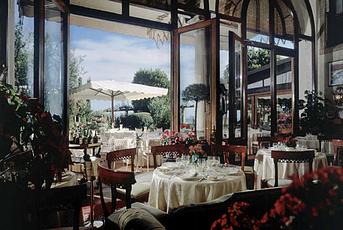 There are also daily specials that include lustier dishes
like luganica sausage,
suckling pig, and roasted goat.
There are also daily specials that include lustier dishes
like luganica sausage,
suckling pig, and roasted goat.Disma Tessaro makes lovely desserts worthy of the setting and the total refinement of the area, like lemon cake with lemon mascarpone cream and blackberries, and an almond tart with sweet ricotta and honey. Almond milk panna cotta is drizzled with aged balsamico.
Rooms at Villa Cipriani begin at about $330 and go up to about $550. Dinner, without wine, but including tax and service will run about $60 per person.
The town of Asolo, known as "the city of a hundred horizons," is as quaintly beautiful as Villa Cipriani, which is set just off one of the main--if narrow--streets, Via Canova. Every second Sunday of the month there is an antiques fair, and music festivals are held here often. The town has its own fortress and castle, a city museum, and of course, and a medieval cathedral containing the works of Renaissance artists Lorenzo Lotto, Bassano, and Sebastiano Bastiani.
After the Villa Cipriani, the loveliest place to stay is the small Albergo al Sole (Via Collegio 33; 39-0423-951-332; right), with a terrace restaurant that overlooks the piazza of town and the comings-and-goings
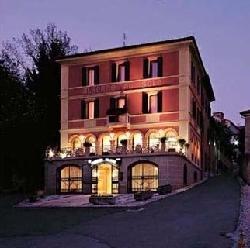 of the locals and visitors who stop in Asolo. The
hotel has 23 rooms, a fitness room, and cooking lessons. Rooms begin
around $275.
of the locals and visitors who stop in Asolo. The
hotel has 23 rooms, a fitness room, and cooking lessons. Rooms begin
around $275.One of the darling places we stopped for dinner was Osteria Ristorante Ca' Derton (Piazza D'Annunzio 11; 39-0423-529648), a sophisticated but extremely amiable restaurant under the archway off the Piazza. With its pink walls, terracotta floors, hanging lights covered with linen napkins, wooden beams, a rustic stone wall, and an antique chest with an equally antique phonograph, the dining room (below) could well be someone's home, and the feminine touch of an all-woman staff is evident in every graceful movement of service. The man of the house, Nino, is the chef, while his wife Antonietta takes care of the front of the dining room, as they have since 1993.
 There is a superb winelist, with a good selection of
Veneto wines, and the menu is just the right size for this small
ristorante to serve
well. Every guest receives a glass of
prosecco with four different breads and grissini on the table, then an
amuse; ours was a cream
of asparagus with porcini. We
tasted three
pastas: lasagnette with
vegetables and prawn; gnocchi with tomato and
basil; and saffron tortelli
stuffed with duck and strips of
celery. All were made minutes before service.
There is a superb winelist, with a good selection of
Veneto wines, and the menu is just the right size for this small
ristorante to serve
well. Every guest receives a glass of
prosecco with four different breads and grissini on the table, then an
amuse; ours was a cream
of asparagus with porcini. We
tasted three
pastas: lasagnette with
vegetables and prawn; gnocchi with tomato and
basil; and saffron tortelli
stuffed with duck and strips of
celery. All were made minutes before service.We then had a lightly poached sea bass with very fine olive oil, potatoes, fennel, and carrots, and faorona (guinea fowl) with liver forcemeat, accompanied with the white polenta of Veneto. Our favorite was a rabbit torta, also with polenta, and white and green asparagus. This is charmingly simple food done with obvious finesse, as was a dessert called "3 Dames"--excellent custards scented with lavender, coffee, and prosecco. There was also crisp pear strüdel with gooseberries and crème anglaise, and a finish-off of meringue and hazelnut cookies.
Then we strolled back to the piazza, had an espresso at a café, and let life slow down under a yellow moon.
A 3-course meal at Ca'Derton will cost about $50 per person, before wine, but including tax and service.
NEW YORK CORNER
by John Mariani
THE E.U.
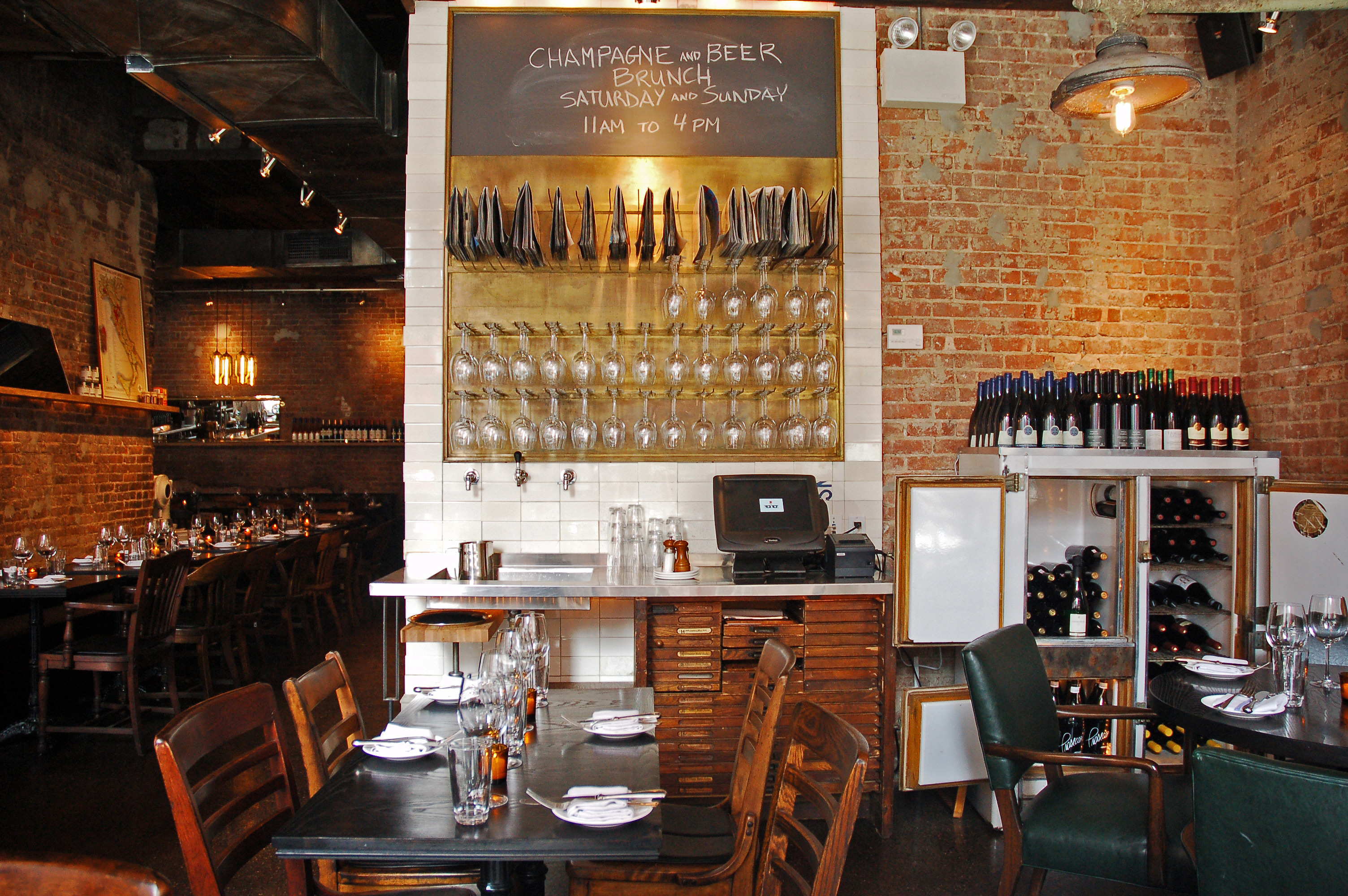
212-254-2900
Alphabet City is the moniker given to that section of the East Village whose North-South streets run A to D from Tompkins Square towards the East River, a heavily Latino neighborhood also called, in patois, "Loisaida." Composed mostly of old tenements, the area has enjoyed a certain revivification of late due in large part to the scads of restaurants opening on every street. Most of them are fairly standard ethnic eateries but The E.U. is quite another thing: while taking full advantage of the old structure it occupies, with rough brick walls, industrial-style lighting, and massive wooden ceiling beams, so you get a feeling of the old neighborhood itself. The owners, Jason Hennings and Bob Giraldi, have also installed a handsome white porcelain wall, a sturdy 1930s porcelain bar where artisanal beers are poured, roomy leather booths, and an open kitchen where you can kibbitz with the staff. There is also a communal farm table that's become very popular with solo diners.
The menu, under chef Akhtar Nawab (below), formerly of Craft and Craftbar, can seem a little bewildering at first glance, printed on a brown paper broadsheet that begins in the upper left corner with oysters and tapas like steak tartare and baccala croquettes then moves up and down to "Salumi-Jamon," cheeses, first courses, plats du jour, "plats principaux," sandwiches, burgers, and sides. If this seems a bit of a stretch, as in something-for-everyone, it is not:
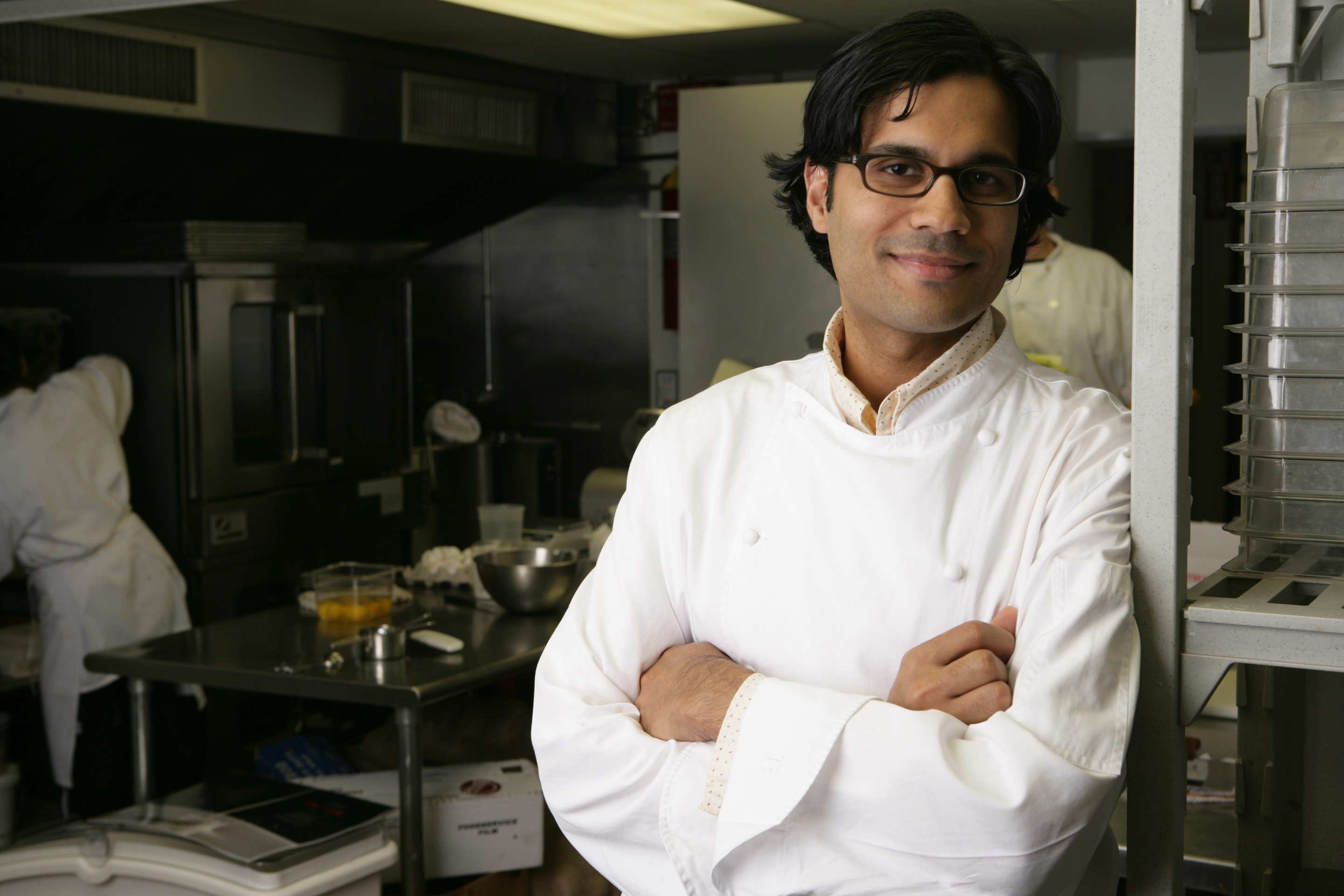 Everything on the menu is distinctly in the
same vein of lusty European cooking--the restaurant's name, of course,
refers to the European Union--with some Italian, some French, even some
German dishes that co-habitate successfully and quite generously on the
plate: they call it a gastro-pub. Indeed, I highly recommend
having most dishes family style so that everyone can have a little coppa, prosciutto, madrange ham,
mortadella, and liverwurst with country bread, or a nice selection of
French, German, and Spanish cheese.
Everything on the menu is distinctly in the
same vein of lusty European cooking--the restaurant's name, of course,
refers to the European Union--with some Italian, some French, even some
German dishes that co-habitate successfully and quite generously on the
plate: they call it a gastro-pub. Indeed, I highly recommend
having most dishes family style so that everyone can have a little coppa, prosciutto, madrange ham,
mortadella, and liverwurst with country bread, or a nice selection of
French, German, and Spanish cheese.You can do the same with a dish of vegetables with a summer truffled vinaigrette and the bruschetta topped with melted burrata cheese, a white anchovy, arugula pesto, a fried egg, and pistachio nuts, which is not nearly so complicated as it sounds, just damn delicious. Parisian gnocchi are pea-sized dumplings with the surprise of Peekytoe crabmeat and peas (these I'd like to keep all to myself). A plump fricassee of quail cooked a la plancha comes with a thin slice of foie gras with cherry agrodolce, and pappardelle is pumped up with corn, black cabbage, and summer truffles. Paella was a bit tame and too soupy to be considered traditional.
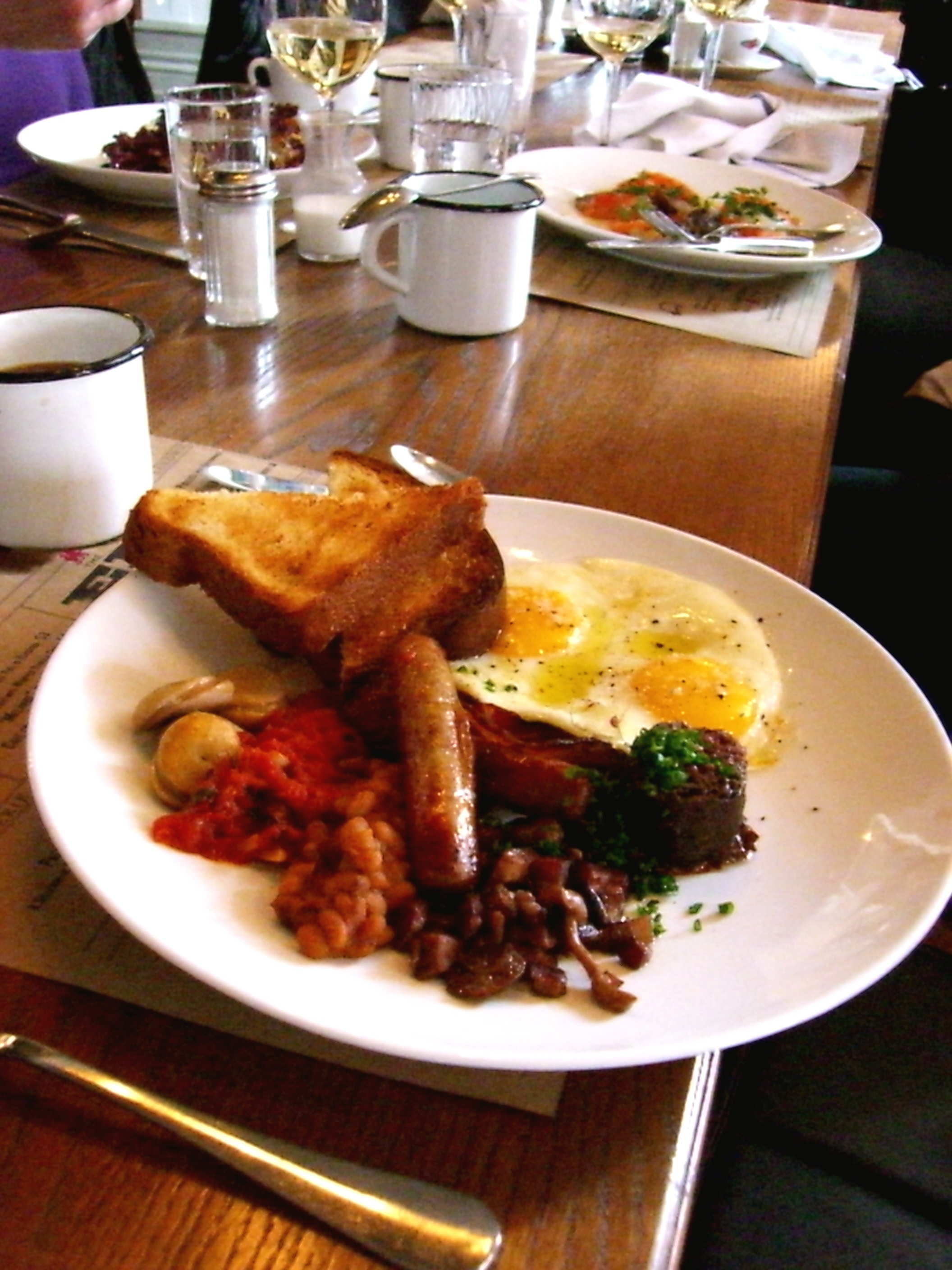
Roasted striped bass, perfectly juicy, came with fennel, fingerling potatoes, and well-rendered light Béarnaise, and I was especially impressed with the crispiness of the skin on roast suckling pig with string beans and hazelnuts. The night I visited the plat du jour was orrechiette (ear-shaped) pasta with sausage and rapini greens--a tour de force of incorporating common ingredients to an elevated status.
For dessert there are all kinds of scrumptious sweets, from English sticky toffee pudding with caramel gelato, beignets with milk jam and chocolate sauce, tarte Tatin with vanilla gelato.
The E.U. is a place whose good vibes are palpable as soon as you step through the door and right now it is a bellwether in this slowly developing neighborhood.
The E.U. is open for lunch Mon. – Fri. dinner daily Sun. – Thurs. Brunch is served Sat.& Sun.
NOTES FROM THE WINE CELLAR

I have written with enthusiasm about an array of inexpensive wines from
Well, the good news is that an increasing number of monastrell wines are coming into the
The best known—so far—are the wines from Jumilla, which lies between the Cartagena and Castilla. The red wines are known for their intensity, which comes from deep-rooted vines in a micro-climate that gets only about ten inches of rainfall each year, so the vines have to struggle to produce. The yields from Yecla, northeast of the regional capital of Murcia, and Bullas, southwest of it, produce lower yields than Jumilla, hence their limited supply in the international market.
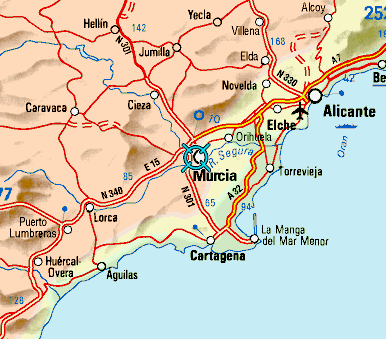
Monastrell is the fourth largest varietal planted in
After years of decline, some Spanish vintners are trying revive the varietal because it has taken on a new luster as a component of the now popular
When made in large volume, monastrell can be a dark, highly tannic, even inky wine that might well turn your teeth purple. But the fine examples now being exported have much of the complexity of
In a tasting of several recent vintage Murcia monastrell-based wines I found they all showed an initial charge of fresh, dark currant flavors followed by minerality, then a sure shot of tannin. None could be considered a light red. All can stand some age, though I can’t say how much better they might become. At prices ranging from $9-$29, I’m happy to drink them right now with roasted or grilled red meats, and, as I found out at a "Estilo Libre Latino" (freestyle Latino) restaurant named Rayuela in New York, monastrell went very well pan-seared sweetbreads with crispy potatoes, bacon, and arugula, and with the sweet-salty edge of grilled papaya stuffed with duck confit in a sherry sauce.
Bodegas Bleda dates back to 1935 and has been exporting since the end of World War II to the
La Purisima 2004 Trapio ($29) is 100 percent monastrell and only 100 cases are made each year by this very large Yecla winery, founded in 1946. With 14 percent alcohol it is big, bold, and has a lot of licorice and chocolate notes, making it ideal for a hearty stew or a Spanish cheese like manchego.
Finca Omblancas is a 5-year-old Jumilla winery high up in the hills at 1,600 feet. Their 2004 Delain is 70 percent monastrell, with some cabernet and syrah blended in to give it complexity while still expressing the virtues of monastrell in its ripeness of cherry and vanilla flavors.
 Casa de la Ermita, started only ten years
ago, is considered one of the most modern wineries in
Casa de la Ermita, started only ten years
ago, is considered one of the most modern wineries in Casa de las Especias obtains only very small yields and produces only organic wines, including their 2003 Crianza $24, which is 40 percent monastrell, with the rest cabernet and syrah, which give it floral notes and a sweet spiciness up front and a lingering peppery spice in the finish.
Though of recent origin, 2001, Valle de Salinas, in the heart of the Yecla region, has monastrell vineyards that are very old and produce wines of intensity, even without any oak aging, evident in the 2005 Joven, which is of medium body with plenty of fresh, fruity notes and, especially for a wine that retails for only $9, admirable finesse. I’d happily drink it with roast chicken or pork.
At a time when many Spanish wineries are trying to get into the saturated market for cabernet and merlot, it is app laudable that these Murcia producers fervently believe that their own native varietal can show they have the right stuff to succeed on their own.
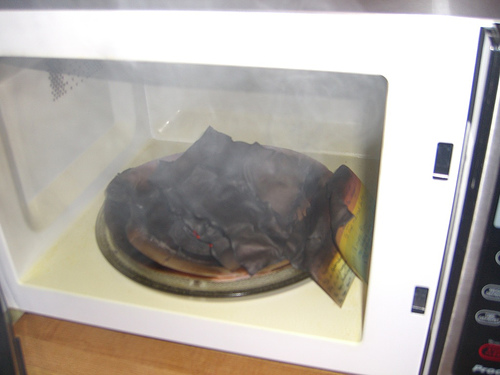
NEW TERRORIST THREAT!
En route from London to Miami, an employee of British Airways tried to heat up frozen curry in a microwave oven at 35,000 feet and the curry exploded, causing $40,000 damage but the fire was put out before any damage and danger occurred.
THE WINNER COVERED THE DISTANCE TWELVE HOURS, TEN MINUTES
In
QUICK BYTES
* On Sept. 2 The 15th Annual Sonoma Valley Harvest Wine Auction takes place at Cline Cellars. Highlights from this year’s list of more than 55 auction lots incl. a Toyota Prius and free gas for one year;
* Beginning Sept. 3,
* During Sept. & Oct. NYC’s Zarela celebrates its 20th anniversary with a series of events, incl.: Grand Raffle Tickets to benefit the Mexican Cultural Institute of NY, with prizes incl. three 2-person trips to Mexico with itineraries planned by Zarela Martinez; a new interactive web portal with how-to videos, links to the Mexican Cultural Institute, the Mexican Museum of Art in Chicago, et al.; Sept. 30, Oct. 1-2, Customer Appreciation Days, with half-price Margaritas and complementary appetizer plate. On Sept. 4
* On Sept. 6 Shaw's Crab House Chicago is hosting a 6-course wine dinner with Iron Horse Vineyards, with owner Joy Sterling, and Shaw's Wine and Spirits Director Steve Tindle and Executive Chef Arnulfo Tellez. $99.95 pp. Call 312-527-2722.
* On Sept. 12 (dinner) & 13 (lunch & dinner) Tocqueville in NYC will feature a Rosh Hashanna menu $48 at lunch, $65 at dinner. Call 212-647-1515.
* From Sept. 14-16 in Mashantucket, CT, the 2nd annual Foxwoods Food & Wine Festival will be held with wine experts Ray Isle, Anthony Giglio, Joe Bastianich, and Divas Uncorked, and chefs incl. Lidia Bastianich, David Burke, Giada de Laurentiis, Dave Lieberman, Masaharu Morimoto, Michael Schlow and Ming Tsai, with proceeds to the College of Culinary Arts at Johnson & Wales U. Visit www.foxwoodsfoodandwine.com.
* Hart Davis Hart Wine Co. in
From Sept.
12-19 Western
Australia Wines will hold a medley of events in NYC dubbed “Taste of
Western
Australia,” with 21 wineries, incl. 8 producers at the Morrell Wine
Store in
* On Sept. 19 in Washington, DC , the Park Hyatt Washington salutes the “Masters of Food & Wine Argentina,” a dinner pairing award-winning wines from the Vines of Mendoza prepared by 5 Argentinean chefs: Fernando Trocca, of Buenos Aires' Sucre and El Diamante and NYC’s Industria Argentina; Juan Manuel Guizzo of Bistro M, Park Hyatt Mendoza; Màximo López May, Restaurant Goia, Palacio Duhau - Park Hyatt Buenos Aires; Juliana López May, Owner, Taller de Cocina- Buenos Aires, and Maximo Togni, Embassy of Argentina. VIP reception, followed by a 5-course dinner in the Blue Duck Tavern. The honorary patrons of the evening are His Excellency José Octavio Bordón, Ambassador of Argentina, and Mrs. Monica Bordón. $250. Call 202-419-6755.
Everett Potter's Travel Report:
Tennis Resorts Online: A Critical Guide to the World's Best Tennis Resorts and Tennis Camps, published by ROGER COX, who has spent more than two decades writing about tennis travel, including a 17-year stretch for Tennis magazine. He has also written for Arthur Frommer's Budget Travel, New York Magazine, Travel & Leisure, Esquire, Money, USTA Magazine, Men's Journal, and The Robb Report. He has authored two books-The World's Best Tennis Vacations (Stephen Greene Press/Viking Penguin, 1990) and The Best Places to Stay in the Rockies (Houghton Mifflin, 1992 & 1994), and the Melbourne (Australia) chapter to the Wall Street Journal Business Guide to Cities of the Pacific Rim (Fodor's Travel Guides, 1991). Click on the logo below to go to the site.
~~~~~~~~~~~~~~~~~~~~~~~~~~~~~~~~~~~~~~~~~~~~~~~~~~~~~~~~~~~~~~~~~~~~~~~~~
MARIANI'S VIRTUAL GOURMET NEWSLETTER is published weekly. Editor/Publisher:
John Mariani. Contributing Writers: Robert Mariani, Naomi
Kooker, Kirsten Skogerson, Edward Brivio, Mort
Hochstein, Suzanne Wright. Contributing
Photographers: Galina Stepanoff-Dargery, Bobby Pirillo. Technical
Advisor: Gerry McLoughlin.
Any of John Mariani's books below
may be ordered from amazon.com by clicking on the cover image.
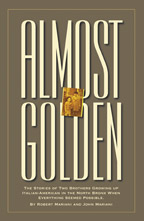 My
newest book, written with my brother Robert Mariani, is a memoir of our
years growing up in the My
newest book, written with my brother Robert Mariani, is a memoir of our
years growing up in the For those of you who don't think of the Robert and I think you'll enjoy this very personal look at our --John Mariani |
 |
 |
 |
 |
 |
 |
copyright John Mariani 2007

